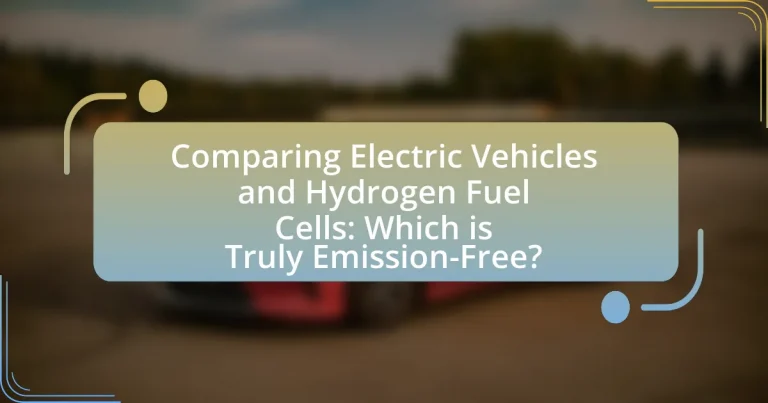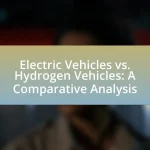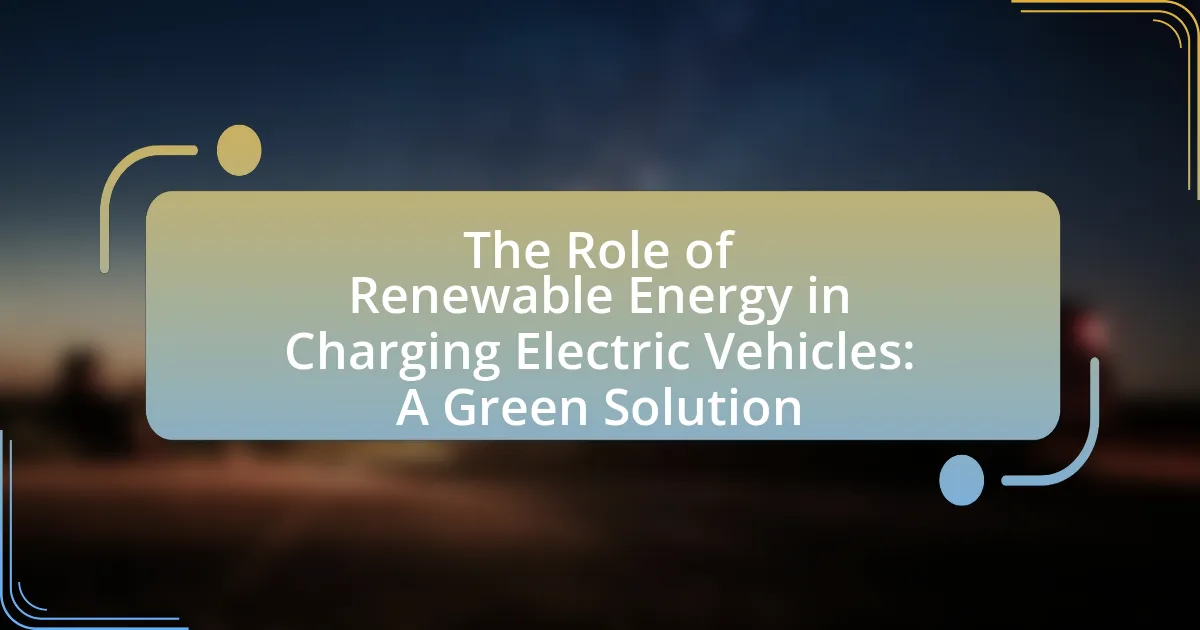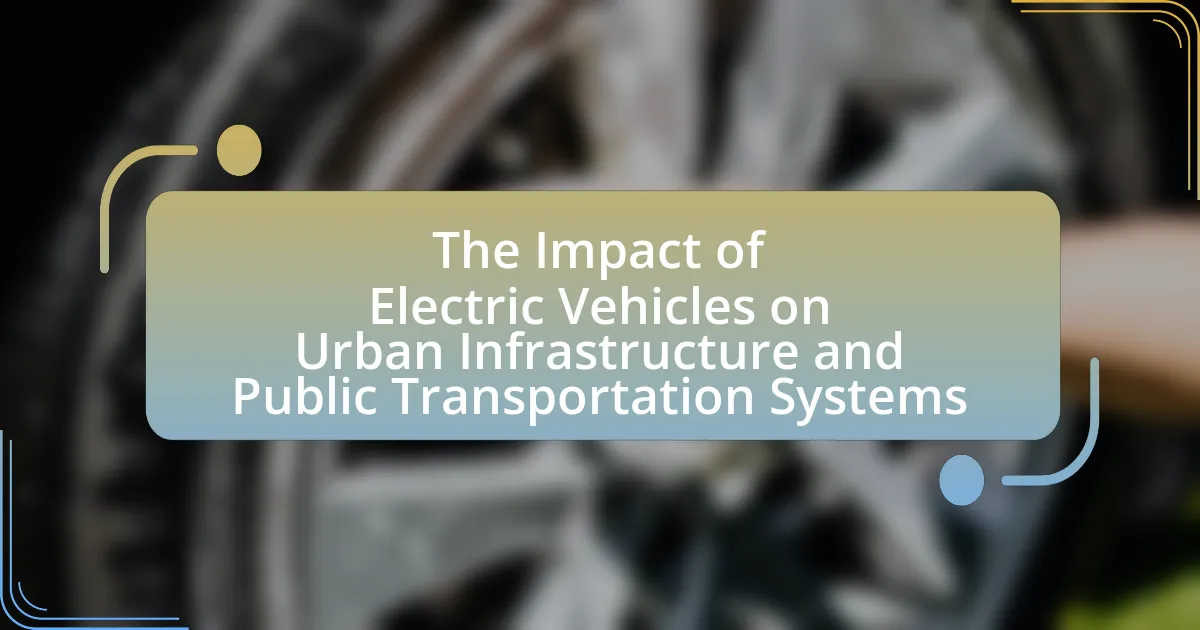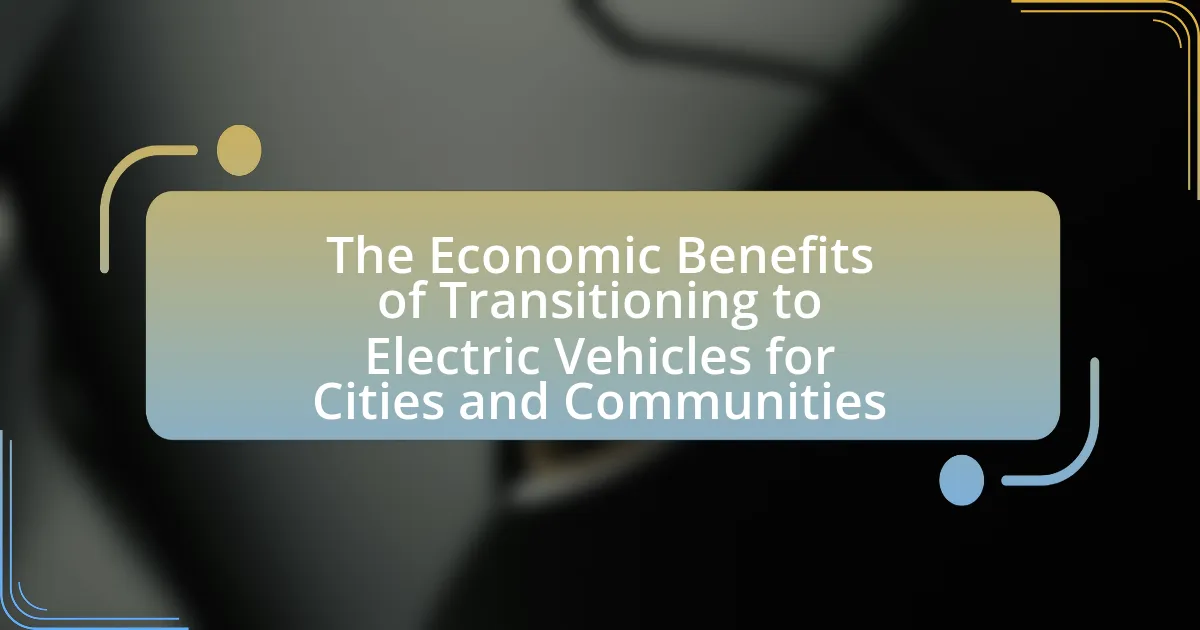Electric vehicles (EVs) and hydrogen fuel cells represent two innovative technologies aimed at reducing greenhouse gas emissions in the transportation sector. This article provides a detailed comparison of these technologies, examining their operational mechanisms, key components, and environmental impacts. It highlights how EVs operate using electric motors and batteries, while hydrogen fuel cells convert hydrogen gas into electricity through chemical reactions. The discussion includes lifecycle emissions, energy efficiency, and the advantages and challenges of each technology, ultimately assessing which option is more sustainable and emission-free. Additionally, the article explores the role of government policies and consumer considerations in the adoption of these technologies.
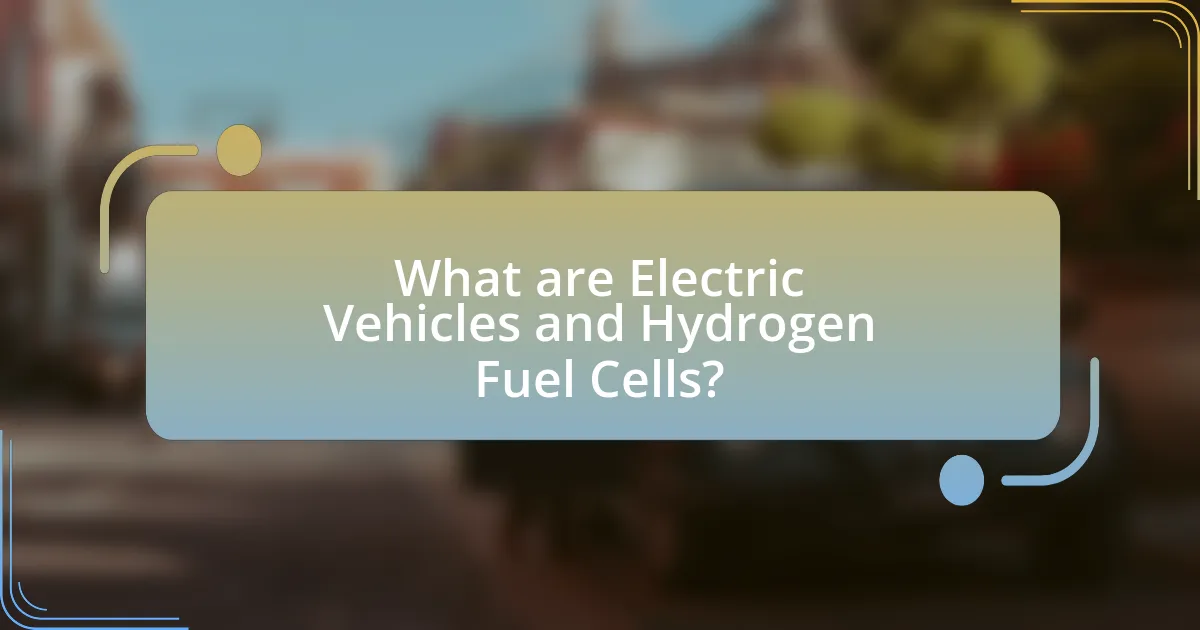
What are Electric Vehicles and Hydrogen Fuel Cells?
Electric vehicles (EVs) are automobiles that are powered entirely or partially by electricity, utilizing electric motors and batteries for propulsion. Hydrogen fuel cells, on the other hand, are devices that convert hydrogen gas into electricity through a chemical reaction, producing only water and heat as byproducts. Both technologies aim to reduce greenhouse gas emissions compared to traditional internal combustion engines. According to the U.S. Department of Energy, EVs can significantly lower emissions, with studies showing that they can reduce greenhouse gas emissions by up to 70% compared to gasoline vehicles, depending on the electricity source. Hydrogen fuel cells also offer a clean alternative, with the U.S. Department of Energy noting that they emit no harmful pollutants during operation.
How do Electric Vehicles operate?
Electric vehicles (EVs) operate by using electric motors powered by rechargeable batteries instead of internal combustion engines. The electric motor converts electrical energy from the battery into mechanical energy, propelling the vehicle. EVs utilize regenerative braking, which captures energy during braking and feeds it back into the battery, enhancing efficiency. According to the U.S. Department of Energy, EVs can convert over 60% of the electrical energy from the grid to power at the wheels, significantly higher than conventional gasoline vehicles, which typically convert only about 20% of the energy stored in gasoline.
What are the key components of Electric Vehicles?
The key components of Electric Vehicles (EVs) include the electric motor, battery pack, power electronics, and charging system. The electric motor converts electrical energy into mechanical energy to drive the vehicle, while the battery pack stores the energy needed for operation. Power electronics manage the flow of electrical energy between the battery and the motor, ensuring efficient performance. The charging system allows the battery to be recharged from an external power source. These components work together to enable the functionality and efficiency of electric vehicles, contributing to their role in reducing emissions compared to traditional combustion engines.
How do Electric Vehicles generate power?
Electric vehicles generate power through electric motors that convert electrical energy stored in batteries into mechanical energy for propulsion. The batteries are charged using electricity from various sources, including the grid, renewable energy, or regenerative braking systems that capture energy during deceleration. This process is efficient, with electric motors typically achieving over 90% efficiency in converting electrical energy to movement, compared to internal combustion engines that average around 20-30% efficiency.
What are Hydrogen Fuel Cells?
Hydrogen fuel cells are electrochemical devices that convert hydrogen and oxygen into electricity, with water and heat as the only byproducts. This process occurs through a reaction in which hydrogen gas is fed into the anode side of the fuel cell, while oxygen is supplied to the cathode side. The chemical reaction generates electricity, which can be used to power electric motors in vehicles. According to the U.S. Department of Energy, hydrogen fuel cells can achieve efficiencies of up to 60%, making them a promising technology for clean energy applications.
How do Hydrogen Fuel Cells function?
Hydrogen fuel cells function by converting chemical energy from hydrogen and oxygen into electrical energy through an electrochemical reaction. In this process, hydrogen gas is supplied to the anode side of the fuel cell, where it is split into protons and electrons. The protons pass through a proton exchange membrane to the cathode side, while the electrons travel through an external circuit, generating electricity. At the cathode, oxygen from the air combines with the protons and electrons to produce water and heat as byproducts. This mechanism allows hydrogen fuel cells to generate electricity efficiently, with water being the only emission, thus supporting the claim of being emission-free.
What are the main components of Hydrogen Fuel Cells?
The main components of hydrogen fuel cells are the anode, cathode, electrolyte, and the fuel supply system. The anode is where hydrogen gas is introduced and split into protons and electrons. The electrolyte allows only protons to pass through while blocking electrons, which travel through an external circuit to generate electricity. The cathode is where oxygen is introduced, and it combines with the protons and electrons to produce water and heat as byproducts. These components work together to convert chemical energy from hydrogen into electrical energy efficiently.
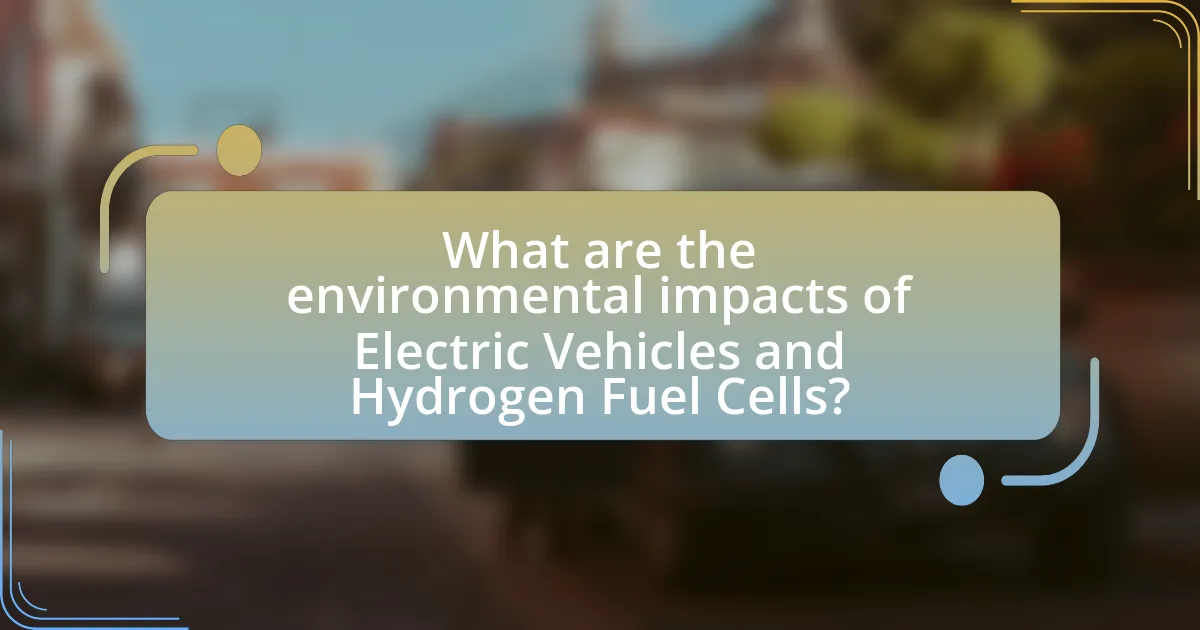
What are the environmental impacts of Electric Vehicles and Hydrogen Fuel Cells?
Electric vehicles (EVs) and hydrogen fuel cells both have significant environmental impacts, primarily related to their energy sources and lifecycle emissions. EVs produce zero tailpipe emissions, but their overall environmental impact depends on the electricity generation mix; for instance, coal-heavy grids result in higher emissions compared to renewable sources. According to the Union of Concerned Scientists, EVs can reduce greenhouse gas emissions by 50% or more compared to conventional vehicles when charged from clean energy sources.
Hydrogen fuel cells emit only water vapor during operation, but the environmental impact largely hinges on hydrogen production methods. Currently, most hydrogen is produced through steam methane reforming, which emits substantial CO2. A study by the International Energy Agency indicates that transitioning to green hydrogen, produced via electrolysis using renewable energy, could significantly lower emissions.
In summary, while both technologies offer pathways to reduce emissions, their environmental impacts vary based on energy sources and production methods.
How do Electric Vehicles contribute to reducing emissions?
Electric vehicles (EVs) contribute to reducing emissions primarily by eliminating tailpipe emissions, which are a significant source of air pollution from traditional gasoline and diesel vehicles. Unlike internal combustion engines, EVs operate on electricity, which can be generated from renewable sources such as wind, solar, and hydroelectric power. According to the U.S. Department of Energy, EVs produce zero emissions during operation, significantly lowering greenhouse gas emissions when charged with clean energy. Additionally, studies indicate that even when charged from the current energy grid, EVs typically result in lower overall emissions compared to conventional vehicles, as the average emissions from power plants are often less than those from gasoline combustion.
What are the lifecycle emissions of Electric Vehicles?
Lifecycle emissions of Electric Vehicles (EVs) encompass emissions generated during production, operation, and disposal phases. Studies indicate that the total lifecycle emissions for EVs can range from 50 to 70% lower than those of conventional internal combustion engine vehicles, depending on the energy source used for electricity generation. For instance, a 2021 study by the Union of Concerned Scientists found that EVs produce, on average, 4,500 pounds less CO2 over their lifetime compared to gasoline vehicles, when accounting for emissions from electricity generation. Additionally, battery production contributes significantly to lifecycle emissions, with estimates suggesting that manufacturing a lithium-ion battery can emit around 150 to 200 kg of CO2 per kWh of capacity. However, as renewable energy sources become more prevalent, the operational emissions of EVs are expected to decrease further, enhancing their overall environmental benefits.
How does the energy source for Electric Vehicles affect their emissions?
The energy source for Electric Vehicles (EVs) significantly affects their emissions, as the carbon footprint of EVs largely depends on how the electricity used to charge them is generated. For instance, if the electricity comes from renewable sources like wind or solar, the emissions associated with operating the EV are minimal, often resulting in a net-zero or very low emissions profile. Conversely, if the electricity is generated from fossil fuels, such as coal or natural gas, the emissions can be substantial, potentially negating the environmental benefits of using an EV. According to the U.S. Department of Energy, the lifecycle emissions of EVs can vary widely, with estimates showing that EVs charged with coal-powered electricity can produce emissions comparable to or even exceeding those of conventional gasoline vehicles.
What are the emissions associated with Hydrogen Fuel Cells?
Hydrogen fuel cells primarily emit water vapor as a byproduct of the electrochemical reaction that generates electricity. However, the overall emissions associated with hydrogen fuel cells depend on the method of hydrogen production. If hydrogen is produced through electrolysis using renewable energy, the emissions are minimal. Conversely, if hydrogen is derived from natural gas through steam methane reforming, significant carbon dioxide emissions occur, estimated at about 9-12 kg of CO2 per kg of hydrogen produced. Thus, while the operation of hydrogen fuel cells is clean, the emissions linked to hydrogen production can vary widely based on the energy source used.
How is hydrogen produced and what are its emissions?
Hydrogen is primarily produced through methods such as steam methane reforming (SMR), electrolysis, and gasification. Steam methane reforming, which accounts for about 95% of hydrogen production, involves reacting natural gas with steam to produce hydrogen and carbon dioxide. This process emits significant greenhouse gases, approximately 9-12 kg of CO2 per kg of hydrogen produced. Electrolysis, which splits water into hydrogen and oxygen using electricity, can be emission-free if powered by renewable energy sources; however, if the electricity comes from fossil fuels, emissions can still occur. Gasification converts organic materials into hydrogen and can also produce emissions depending on the feedstock and process efficiency. Overall, the emissions associated with hydrogen production vary significantly based on the production method and energy sources used.
What are the lifecycle emissions of Hydrogen Fuel Cells?
The lifecycle emissions of hydrogen fuel cells vary significantly based on the production method of hydrogen. When hydrogen is produced via steam methane reforming, it can emit approximately 9 to 12 kg of CO2 per kg of hydrogen. In contrast, hydrogen produced through electrolysis using renewable energy sources can result in near-zero emissions. A comprehensive analysis by the International Energy Agency indicates that the overall lifecycle emissions for hydrogen fuel cells can range from 0 to 12 kg of CO2 per kg of hydrogen, depending on the production pathway and energy sources utilized.

Which technology is more sustainable: Electric Vehicles or Hydrogen Fuel Cells?
Electric vehicles (EVs) are generally considered more sustainable than hydrogen fuel cells. This is primarily due to the efficiency of energy conversion; EVs convert about 77% of the electrical energy from the grid to power at the wheels, while hydrogen fuel cells convert only about 20% of the energy from hydrogen. Additionally, the production of hydrogen often relies on fossil fuels, which can negate its environmental benefits. According to the U.S. Department of Energy, the majority of hydrogen is produced from natural gas through a process that emits significant carbon dioxide. In contrast, EVs can be powered by renewable energy sources, making them a cleaner option overall.
What are the advantages of Electric Vehicles over Hydrogen Fuel Cells?
Electric vehicles (EVs) have several advantages over hydrogen fuel cells, primarily in terms of efficiency, infrastructure, and cost. EVs convert over 60% of the electrical energy from the grid to power at the wheels, while hydrogen fuel cells typically convert only about 20% of the energy from hydrogen production to power at the wheels. Additionally, the existing charging infrastructure for EVs is more developed and widespread compared to hydrogen refueling stations, which are limited in number. Furthermore, the overall cost of operating and maintaining EVs tends to be lower than that of hydrogen fuel cell vehicles, as EVs benefit from fewer moving parts and lower fuel costs.
How do Electric Vehicles compare in terms of energy efficiency?
Electric vehicles (EVs) are significantly more energy efficient than traditional internal combustion engine vehicles. EVs convert approximately 60-77% of the electrical energy from the grid to power at the wheels, while gasoline vehicles typically convert only about 12-30% of the energy stored in gasoline. This higher efficiency is due to the electric motor’s ability to utilize energy more effectively and the regenerative braking systems that recover energy during deceleration. Additionally, studies indicate that EVs produce fewer greenhouse gas emissions over their lifecycle compared to gasoline vehicles, further highlighting their energy efficiency advantages.
What are the cost implications of Electric Vehicles versus Hydrogen Fuel Cells?
Electric Vehicles (EVs) generally have lower operational costs compared to Hydrogen Fuel Cells (HFCs). The average cost of electricity for EVs is about $0.13 per kilowatt-hour, translating to approximately $4 per gallon equivalent of gasoline, while hydrogen fuel can cost around $16 per kilogram, equating to about $6 per gallon equivalent. Additionally, EVs benefit from lower maintenance costs due to fewer moving parts and no need for oil changes, while HFCs require more complex systems and maintenance. According to a study by the International Council on Clean Transportation, the total cost of ownership for EVs is expected to be significantly lower than that of HFCs over the vehicle’s lifespan, primarily due to these factors.
What are the advantages of Hydrogen Fuel Cells over Electric Vehicles?
Hydrogen fuel cells offer several advantages over electric vehicles, primarily in terms of refueling time, range, and energy density. Refueling a hydrogen fuel cell vehicle typically takes about 3 to 5 minutes, significantly faster than the charging time for electric vehicles, which can range from 30 minutes to several hours depending on the charging infrastructure. Additionally, hydrogen fuel cells provide a longer driving range, with many models exceeding 300 miles on a single tank, compared to electric vehicles that often have a range of 200 to 300 miles per charge. Furthermore, hydrogen has a higher energy density than batteries, allowing for lighter fuel storage and potentially more efficient energy use in larger vehicles, such as buses and trucks. These factors make hydrogen fuel cells a compelling alternative for applications requiring quick refueling and extended range.
How do Hydrogen Fuel Cells perform in terms of refueling time and range?
Hydrogen fuel cells typically allow for refueling in about 3 to 5 minutes, similar to conventional gasoline vehicles. This quick refueling time is a significant advantage over battery electric vehicles, which can take hours to recharge. In terms of range, hydrogen fuel cell vehicles generally offer a driving range of approximately 300 to 400 miles on a full tank, depending on the model. For instance, the Toyota Mirai has a range of around 402 miles, demonstrating the efficiency and practicality of hydrogen fuel cells for long-distance travel.
What are the potential applications of Hydrogen Fuel Cells beyond transportation?
Hydrogen fuel cells have potential applications beyond transportation, including stationary power generation, backup power systems, and industrial processes. In stationary power generation, hydrogen fuel cells can provide clean energy for buildings and facilities, reducing reliance on fossil fuels. For backup power systems, they offer a reliable energy source during outages, ensuring continuous operation for critical infrastructure. Additionally, in industrial processes, hydrogen fuel cells can be utilized for high-temperature applications, such as in steel manufacturing, where they can replace carbon-intensive methods, contributing to lower emissions. These applications demonstrate the versatility of hydrogen fuel cells in various sectors, supporting the transition to a more sustainable energy landscape.
What are the challenges faced by both Electric Vehicles and Hydrogen Fuel Cells?
Electric Vehicles (EVs) and Hydrogen Fuel Cells (HFCs) face significant challenges primarily related to infrastructure, cost, and energy efficiency. EVs require extensive charging infrastructure, which is still underdeveloped in many regions, leading to range anxiety among potential users. Additionally, the production of batteries for EVs involves high costs and environmental concerns due to mining practices for lithium and cobalt. HFCs, on the other hand, face challenges in hydrogen production, as most hydrogen is currently derived from fossil fuels, which undermines their emission-free potential. Furthermore, the distribution and storage of hydrogen present logistical difficulties, as hydrogen is highly flammable and requires specialized tanks. Both technologies also contend with competition from traditional internal combustion engines, which remain more established and cost-effective in many markets.
What infrastructure is needed for Electric Vehicles?
Electric vehicles require a comprehensive charging infrastructure, including public charging stations, home charging units, and fast-charging networks. Public charging stations are essential for urban areas and along highways to facilitate long-distance travel, while home charging units allow for convenient overnight charging. Fast-charging networks, such as those developed by companies like Tesla and ChargePoint, enable rapid recharging, significantly reducing downtime for users. According to the International Energy Agency, as of 2021, there were over 1.8 million public charging points globally, highlighting the growing infrastructure necessary to support the increasing adoption of electric vehicles.
What infrastructure is needed for Hydrogen Fuel Cells?
Hydrogen fuel cells require a comprehensive infrastructure that includes hydrogen production facilities, storage systems, distribution networks, and fueling stations. Hydrogen production can be achieved through methods such as electrolysis or steam methane reforming, with facilities needing to be strategically located to ensure efficient supply. Storage systems must be capable of safely holding hydrogen at high pressures or in liquid form, while distribution networks involve pipelines or transport vehicles to deliver hydrogen to fueling stations. These stations must be equipped with specialized dispensers to refuel hydrogen-powered vehicles quickly and safely. The development of this infrastructure is essential for the widespread adoption of hydrogen fuel cell technology, as evidenced by initiatives in countries like Japan and Germany, which have invested heavily in hydrogen infrastructure to support their energy transition goals.
What are the future prospects for Electric Vehicles and Hydrogen Fuel Cells?
The future prospects for Electric Vehicles (EVs) and Hydrogen Fuel Cells (HFCs) are promising, with EVs expected to dominate the market due to advancements in battery technology and infrastructure. According to a report by the International Energy Agency, global EV sales reached 6.6 million units in 2021, a 108% increase from 2020, indicating a strong growth trajectory. In contrast, HFCs are gaining traction in specific sectors, such as heavy-duty transportation, where their longer range and faster refueling times present advantages. The Hydrogen Council projects that hydrogen could account for 18% of the global energy demand by 2050, highlighting its potential role in a diversified energy landscape. Overall, while EVs are likely to lead in passenger vehicles, HFCs will find niche applications, contributing to a broader shift towards sustainable transportation.
How are advancements in technology influencing both Electric Vehicles and Hydrogen Fuel Cells?
Advancements in technology are significantly enhancing the efficiency and performance of both Electric Vehicles (EVs) and Hydrogen Fuel Cells (HFCs). For EVs, improvements in battery technology, such as the development of solid-state batteries, are increasing energy density and reducing charging times, which enhances the overall driving range and convenience for users. For instance, solid-state batteries can potentially offer up to 50% more energy density compared to traditional lithium-ion batteries, as reported by researchers at the Massachusetts Institute of Technology.
In parallel, advancements in hydrogen production methods, particularly electrolysis and renewable energy integration, are making HFCs more viable. The use of green hydrogen, produced from renewable sources, is reducing the carbon footprint associated with hydrogen fuel production. According to a report by the International Energy Agency, the cost of green hydrogen is projected to decrease by 30% by 2030, making it a more competitive option against fossil fuels.
Overall, technological innovations are driving both sectors towards greater sustainability and efficiency, with EVs benefiting from enhanced battery technologies and HFCs gaining from cleaner hydrogen production methods.
What role do government policies play in the adoption of these technologies?
Government policies significantly influence the adoption of electric vehicles and hydrogen fuel cells by providing incentives, regulations, and infrastructure support. For instance, policies such as tax credits, rebates, and grants encourage consumers and manufacturers to invest in these technologies, leading to increased market penetration. According to the International Energy Agency, countries with strong government support, like Norway, have seen electric vehicle adoption rates exceed 54% of new car sales in 2020, demonstrating the effectiveness of such policies. Additionally, regulations that mandate emissions reductions compel manufacturers to innovate and adopt cleaner technologies, further accelerating the transition to electric and hydrogen-powered vehicles.
What should consumers consider when choosing between Electric Vehicles and Hydrogen Fuel Cells?
Consumers should consider the infrastructure availability, cost of ownership, and environmental impact when choosing between Electric Vehicles (EVs) and Hydrogen Fuel Cells (HFCs). EVs benefit from a growing network of charging stations, with over 100,000 public charging points in the U.S. alone, making them more accessible for daily use. In contrast, HFCs require specialized refueling stations, which are limited, with only about 50 stations in the U.S. as of 2023.
Cost of ownership varies significantly; EVs generally have lower operating costs due to cheaper electricity compared to hydrogen fuel, which can be more expensive to produce and distribute. Additionally, the environmental impact of EVs is often lower, especially when charged from renewable sources, while hydrogen production can involve fossil fuels, affecting its overall emissions profile.
These factors—infrastructure, cost, and environmental impact—are crucial for consumers to evaluate when deciding between EVs and HFCs.
What factors influence the decision-making process for consumers?
The decision-making process for consumers is influenced by several key factors, including personal preferences, social influences, economic conditions, and product attributes. Personal preferences encompass individual values, beliefs, and experiences that shape choices. Social influences involve the impact of family, friends, and societal norms on consumer behavior. Economic conditions, such as income levels and market trends, affect purchasing power and willingness to spend. Product attributes, including quality, price, and environmental impact, play a crucial role in determining consumer preferences, especially in the context of comparing electric vehicles and hydrogen fuel cells, where consumers increasingly prioritize sustainability and emissions.
How can consumers assess the environmental impact of their vehicle choice?
Consumers can assess the environmental impact of their vehicle choice by evaluating factors such as emissions data, fuel efficiency, and lifecycle analysis. Emissions data provides insights into the greenhouse gases produced during operation, while fuel efficiency indicates how much energy is consumed per distance traveled. Lifecycle analysis examines the environmental effects from production to disposal, including resource extraction and manufacturing processes. For instance, electric vehicles typically have lower operational emissions compared to traditional gasoline vehicles, but their overall impact depends on the energy source used for electricity generation. According to the U.S. Department of Energy, electric vehicles can reduce greenhouse gas emissions by up to 50% compared to conventional vehicles, especially when charged with renewable energy.
